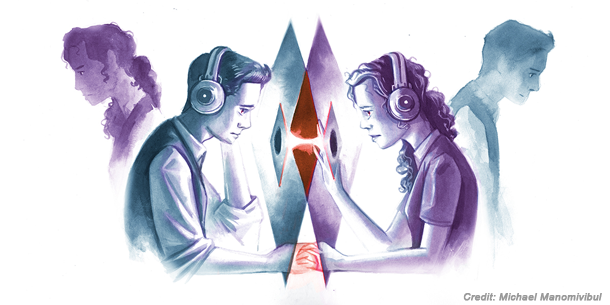Submitted by Tara Abrishami
on November 29, 2015

QUANTUM SHORTS 2015: FIRST PRIZE, YOUTH CATEGORY
>>Read an interview with the author
In one universe…
I grip my coffee with one hand and lean against the railing as the shuttle meanders toward the cluster of tall, white buildings. Le Centre pour la Recherche Physique Spécial, usually called simply Le Centre, is tucked in among the green hills and lazy rivers of rural France. The local folk call it Le Château Blanc, and it does resemble a white castle somewhat, albeit a contemporary one, home to an odd array of knights. We knights, scientists, come to Le Centre to study everything from quantum entanglement to Hawking radiation. And I, fresh out of Oxford, for Project Bifröst.
I step off the shuttle at Building 221, a hulking glass building toward the outskirts of the establishment. The facilities are immaculate. Everything is sleek and modern, from the most expensive particle accelerators to the ordinary snow-white escalators, so unlike the clumsy gray ones of antiquity. On the third floor, the bright, minimalist décor falters with the navy words embellished on the wall: Project Bifröst.
My boss, Dr. Tolbert, motions to me from the door of his office.
“Clara,” he says, “the new communications equipment has been delivered.”
“Already? That’s great. Stephen and I will work with it right away,” I answer.
He nods. “Good.”
Project Bifröst is the most ambitious communications project European research has ever attempted. The project endeavors to prove the existence of the multiverse, to somehow detect an alternate reality. There are different branches, like trying to detect radiation that would imply another universe, but Stephen and I are working on the boldest option: direct communication with a parallel universe.
He’s bent over the new equipment when I walk in to the lab. He looks up and I steal a swift glance at my glass reflection. My curls, ordinarily tied up, are loosely tousled around my face; I look softer, more feminine than usual. But Stephen has eyes only for the gorgeous new technology.
“Come and look, Clara,” he says, beckoning.
To the best of our knowledge, communication across multiple universes defies most standard physical laws, but the equipment still outwardly resembles that of a century ago. A satellite dish has been reconfigured to detect gravitational waves in a pocket of quantum foam. Inside the magnetic shield, positron annihilation fuels the jewel of the system: a microscopic wormhole, just wide enough to transmit the carefully laser-modulated signals. All experimental technology, developed in the last couple years specifically for Project Bifröst.
Stephen plays with the bulky headset. It’s endearingly primitive, the headset, something a World War III pilot may have worn. I reach for it, my knuckles lightly grazing Stephen’s as he passes it to me. I ignore the warmth rushing to my fingers as Stephen turns to set up the transmitter. Light floods the lab as he pulls open the blinds, shadows painting patterns on the shiny marble floor.
A green light flashes on the headset, and Stephen turns to smile at me.
“Well, it’s functional,” he says. “There’s no reason you can’t start talking now.”
“What should I say?” I ask. There are messages prepared for this, of course, but it seems foolish to start so pompously.
“Anything,” Stephen says. “Just your name, or something. Just try it out before our meeting with Tolbert.”
He walks across the lab into an isolation room as I pull the headset on. The heavy earpieces close around my head like a brace, and I pull the microphone up to my mouth, wiping away the sweat pooling in my palms. It seems wrong, insolent, to broadcast my own name into the void, across the universes. So instead I lean forward and whisper “Stephen” into the microphone, over and over again.
***
In another universe…
Stephen fiddles with the receiver as I start filtering through the recordings from last night, searching for any kind of anomalous signal that could be communication. The cool, dry air in the lab slowly turns my fingers cold. I rub my hands together, but before I can pull on my coat, Stephen leaves the receiver and walks up to me.
“I brought you tea,” he says, handing over a steaming mug. “I thought you might like something hot, the lab gets so chilly these days.”
I take the tea absently.
“Doesn’t look like there’s anything,” I tell him. Other than the occasional stray signal, even our most far-reaching receivers haven’t picked up anything remotely encouraging.
I leave the laptop and walk to the wall, leaning my forehead against the cold glass. I watch the wispy orange clouds sink into the horizon, the indigo fingers of the night sky stretching out above Le Centre. God, the sunset is beautiful out here.
Stephen walks up next to me. “There is a little café with a very nice view not far from here,” he says quietly. “Maybe you’d like to join me there for dinner tonight?”
I rub my wrist uncomfortably, continuing to stare at the mesmerizing sunset. After a few moments, he opens his mouth again, but before he says anything, the machine behind us starts spewing static.
“I’ll get it,” I say, turning, but before I reach the speakers, something more than static comes through.
“Stephen.”
I stare, shock and wonder flitting in and out of Stephen’s wide blue eyes. It continues: Stephen, Stephen, over and over.
“It’s your voice,” he whispers, and as soon as he says it, I know he’s right. I lean heavily against the table, trembling.
“What… what… but that means…” I draw a shaky breath. “Stephen, trace the signal.”
He collapses into the chair and taps around on the laptop. “It’s… it’s not …”
It’s not from this universe. He reaches for my hand, but I pull away.
“This means… oh god. Oh god, we have to go get Tolbert.”
I go, expecting Stephen to follow. But he lingers by the headset, unwilling to part from that infinitesimal moment in which my voice called out from another world, and he heard me.
About the Author
Tara is a freshman at Johns Hopkins University, where she studies, among other things, both physics and creative writing.



